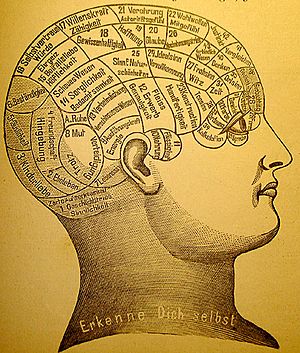Clinical psychology facts for kids

Clinical psychology is a special field that uses science and knowledge to help people with their feelings and thoughts. It helps them understand, prevent, and feel better when they are sad, worried, or have other mental struggles. It also helps people grow and feel good about themselves. Often, clinical psychologists use "talk therapy" instead of medicines. In many places, clinical psychology is a recognized job that helps people's minds.
The first clinic for psychology opened in 1896. It was at the University of Pennsylvania and started by a person named Lightner Witmer. In the early 1900s, clinical psychology mostly focused on testing people's minds. After World War II, many more clinical psychologists were trained. Today, there are two main ways to study this field. One focuses on research (Ph.D. model). The other focuses on helping people directly (Psy.D. model). Clinical psychologists are now experts in talk therapy.
Contents
History of Clinical Psychology
Long ago, people tried to understand and treat mental problems in different ways. These ways often mixed religious, magical, or medical ideas. In the early 1800s, some people thought they could learn about a person's mind by looking at the shape of their skull. This idea was called phrenology. Other popular ideas included studying the shape of a person's face. Some even tried to use magnets to treat mental conditions.
Scientists later realized these methods were not true. At first, academic psychologists did not focus on serious mental illnesses. Doctors called psychiatrists and neurologists already worked with these issues in hospitals. But by the late 1800s, clinical psychology began to grow. This was around the time Sigmund Freud started his "talking cure" in Vienna.
Even as clinical psychology grew, serious mental health issues were still mainly handled by psychiatrists and neurologists. However, clinical psychologists became very good at testing people's minds. This skill helped them become more involved in helping people with mental health problems.
Psychologists became known for their testing skills during World War I. They created two important intelligence tests. Because these tests were so successful, testing became a main part of clinical psychology for about 25 years. Then, World War II brought big changes. It helped the field move more into treating people, not just testing them. This change happened not just in America but all over the world.
A Growing Profession
Since the 1970s, clinical psychology has continued to grow a lot. It is now a strong job and a big area of study. We don't know the exact number of clinical psychologists. But it is thought that between 1974 and 1990, the number in the U.S. grew from 20,000 to 63,000.
What Clinical Psychologists Do
Clinical psychologists do many different things. Some only do research. They study how to test, treat, or understand the causes of mental illness. Some teach students in medical schools or hospitals. Others teach in university departments. Most clinical psychologists work directly with people.
When they work with people, clinical psychologists might help individuals, couples, families, or groups. They work in many places. These include their own private offices, hospitals, mental health centers, schools, and other organizations.
To practice clinical psychology, you need a special license. This is true in the United States, Canada, the United Kingdom, and many other countries. In the U.S., each state has slightly different rules. But there are three common things you need to do:
- Finish school with the right degree from an approved program.
- Complete supervised work experience or an internship.
- Pass a written test. Some states also require an oral test.
Main Ways of Thinking in Clinical Psychology
Clinical psychologists usually learn about one of four main ways of thinking. These are psychodynamic, humanistic, behavior therapy/cognitive behavioral, and systems or family therapy.
Psychodynamic Therapy
Sigmund Freud's ideas led to psychodynamic psychotherapy. This type of therapy helps people understand their hidden thoughts and feelings. It looks at how past experiences might cause problems in the present. The goal is to help clients understand these "unconscious" parts of their mind. This understanding can help them feel better.
Humanistic Therapy
Humanistic psychology started in the 1950s. It was a new way of thinking that reacted to other ideas. One idea was behaviorism, which said that learning and habits cause most human actions. Another was psychoanalysis, which focused on hidden, unconscious thoughts.
The main ideas of humanistic psychology are:
- What is happening now is more important than the past or future.
- People need to take responsibility for their choices to be mentally healthy.
- Every person deserves to be treated with dignity and respect.
- Working on self-improvement and understanding yourself is key to happiness.
Images for kids
-
The University of Pennsylvania was the first to offer formal education in clinical psychology.
See also
 In Spanish: Psicología clínica para niños
In Spanish: Psicología clínica para niños



